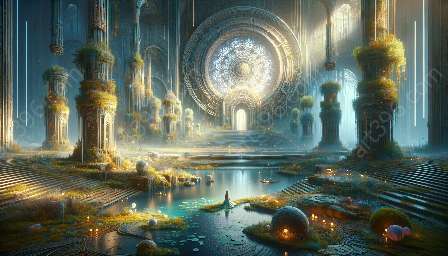Building a fictional world involves creating a coherent and believable setting for the story to unfold. This world-building process encompasses various elements, including geography, culture, history, technology, and political structure. When it comes to designing the political structure of fictional worlds, it is essential to consider how the government and societal power dynamics will influence the narrative, characters, and overall world-building.
Understanding Political Structure in Fictional Worlds
In the context of world-building in concept art, political structure refers to the system of governance, laws, and institutions that govern the fictional society. The political structure shapes the power dynamics, societal norms, and interactions between different groups within the world. This aspect adds depth and realism to the storytelling, making the fictional world more immersive and relatable to the audience.
Connection with Concept Art
Concept art plays a crucial role in bringing fictional worlds to life visually. It involves the creation of visual representations of the world, including landscapes, architecture, characters, and technology. When designing the political structure of a fictional world, concept artists have the opportunity to visually communicate the societal hierarchy, governmental architecture, and cultural symbols associated with the political system. Their artwork contributes to a more profound understanding of the world's political dynamics and conveys the essence of the society within the fictional setting.
Factors to Consider in Political Structure Design
While designing the political structure of fictional worlds, several factors need to be taken into account to ensure a coherent and engaging representation:
- Historical Context: The political structure should reflect the world's history and the societal evolution over time. Historical events, wars, revolutions, and influential leaders can shape the current political landscape.
- Societal Values and Beliefs: The political system should align with the culture and values of the fictional society. Different societies may embrace democracy, monarchy, communism, or other forms of governance based on their cultural norms and beliefs.
- Power Distribution: Examining how power is distributed among different factions, social classes, or individuals within the world is essential. The power dynamics influence societal dynamics, conflicts, and the characters' journeys.
- Institutions and Governance: The creation of governmental institutions, legal systems, and administrative bodies provides insight into how the society functions and interacts with its leadership.
Impact on Storytelling and World-Building
The design of the political structure in fictional worlds significantly impacts the storytelling and world-building process. It influences plot development, character motivations, societal conflicts, and the overall narrative arc. By understanding the intricacies of the political system, authors and artists can create compelling and believable storylines that resonate with the audience.
Conclusion
In conclusion, designing the political structure of fictional worlds is a fundamental aspect of world-building and concept art. It adds depth, coherence, and realism to the fictional setting, enhancing the audience's immersion and emotional connection to the story. By considering historical context, societal values, power distribution, and the impact on storytelling, creators can craft engaging and authentic fictional worlds that captivate and resonate with audiences of all backgrounds.

